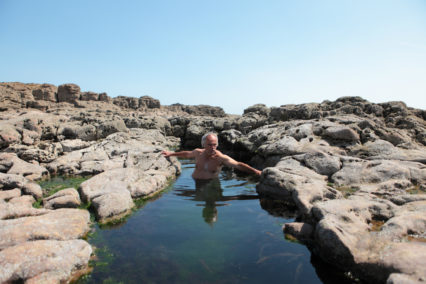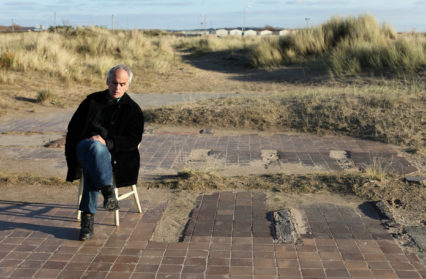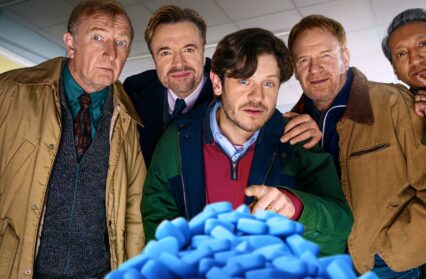Director Eamon Bourke interviews writer Robert Minhinnick about his Wales Book of the Year winning collection, Diary of the Last Man and the new documentary film it has inspired.
Eamon Bourke: Diary of The Last Man has won Wales Book of the Year, judge Carolyn Hitt and Carol Ann Duffy have both commented on the importance and relevance of these ‘vital and visionary’ poems as reactions to and against the times we find ourselves in. I have made a film inspired by some of the poems in this collection and readily recognise the power and scope of this work. But in what ways do you feel your work is addressing the issues we face in 2018? Was the collection intended to be a commentary on our times?
Robert Minhinnick: ‘A commentary on our times’? Nothing so formal or solemn. Diary of the Last Man is the product of 50 years of writing, and is infused with ideas of landscape and the threats to that landscape. But it’s not against change.
I defy anyone not to make art about visits to Amiriya and Babylon in Iraq. My discovery of both places has had a huge impact on how I think and feel. But I had to go there to write, as I have to experience the particularity of places. But those places are different now.
The same goes for the three miles between the mouths of the Ogwr and Cynffig rivers in Wales, where I live.
EB: The collection has been described as a walk across Brexit Britain, what observations political and otherwise can be made about Brexit Britain and how does this manifest in your poetry?
RM: The book is full of politics but not polemics. Maybe it concerns the way we attempt to over-explain the mysteries of Wales and Britain , which are often infused within landscape. ‘’Such digital riches / But no poets or witches”. I distrust ‘explanation’ and any touristification of my landscape but acknowledge it is happening.
 EB: During our shoot for Diary of the Last Man I focused in on the ‘Mouth to Mouth’ poems, a collection within a collection, these poems are inspired by the flora, fauna and landscapes around Porthcawl. Is this the first time you have written about these places in such detail, what do you find so fascinating about these places?
EB: During our shoot for Diary of the Last Man I focused in on the ‘Mouth to Mouth’ poems, a collection within a collection, these poems are inspired by the flora, fauna and landscapes around Porthcawl. Is this the first time you have written about these places in such detail, what do you find so fascinating about these places?
RM: ‘Mouth to Mouth: A Recitation Between Two Rivers’ was a title I decided upon in a bookshop on Broadway, New York. All the flora/fauna was / is experienced by myself during long walks between the rivermouths. It is a deliberate attempt to share the history of the place, but combining it with my journey to Iraq, and our family’s love of astronomy and archaeology.
There is also a good deal of work inspired by such walks in other books. I hope the next novel will partly depend on the same place, i.e. the dunes.
All my writing, whether in Iraq or Wales, seems full of sand, which both reveals and conceals. Sand dunes are temporary and mysterious places, while our coast is rich with legends of inundation. Under the microscope of the artist’s eye sand should be extraordinary.
EB: There is a very real sense in the poetry that these landscapes are both threatened and increasingly rare. As we become a nation of nature reserves and ever diminishing bio diversity are you trying through this work to preserve the memory of these places before they are annihilated?
RM: I think these landscapes will outlast my life, but I never take anything for granted. I’m someone who tries to look at things as if for the first time. The child within us must be encouraged at all costs. I look at my grandchildren’s eyes whenever I take them around Porthcawl fairground and try to learn from them.
My writing tries to combine that fairground with the Babylon I discovered.
EB: In our first filming expeditions into the dunes and beaches around Porthcawl I became interested in an alter ego that appears in your work. A witness. He immerses himself in the landscape, eating hallucinogenic plants picking up and throwing away the detritus on the beaches, wading in the rock pools. The film as I see it is an attempt to capture this figure. Do you recognise him and who is he?
RM: Towards the end of his life my father, Albert Minhinnick (who died aged only 71) stated he was a ‘beachcomber’.
Now I know what I think he meant. Albert was searching for meaning, Maybe I am too, the difference between us being I don’t believe in ‘meaning’, but it’s the search that counts! Love what you find along the way: people, adders, orchids, stars, street corners and buried temples…
EB: About 13 minutes into the film, hidden in a cave in Sker we see this man. Dark skinned, ancient, and observing us. Staring straight down the lens. Who is he and what can he tell us about ourselves?
RM: Writers are witnesses. So he’s a witness. But writers are rarely wise. This dark-skinned man doesn’t know anything, it’s the searching that counts. Maybe he’s understood it’s important to search. Writing is part of that search. It’s one of the things that make us human…
EB: The witness in Diary of the Last Man is there at Kennedys assassination, there watching a Neolithic woman draw creatures in the sand, there amongst the dead of the ship, The Samptampa, wrecked on the rocks at Sker. Are your poems works of history?
RM: Yes, history is a kaleidoscope in the book. The opposite of a straight line. Leyshon, another character, another witness, talks as if he’s been everywhere. He relates famous events in the rivermouths. He also talks about Australia.
I try to allow certain disciplines to crossfertilise one another. I suppose my mind is an untutored mess of archaeology, history, natural history and pop music. Like most people.
EB: How have you found repeated watching of the film?
RM: Difficult. But endurable. I don’t like anything about myself. Really, it’s a film about ‘damage’. No-one can live an undamaged life. Or an undamaging life.
EB: The film feeds off the shifting and changing landscapes within the poetry but also the psychedelic and the delirious. ‘Everyone is warmer today, it a world of delirious children’. What role does delirium play in your work, what inspired this theme?
RM: Delirium I remember, having had meningitis as a child, and being confined in an isolation hospital which is now Sainsbury’s. Maybe my writing tries to combine Sainsbury’s with that hospital. Albert Minhinnick brought home his delirium from Burma and India after WW2.
As a writer you can create imaginary places, but I know I cannot do justice to places that actually existed, such as Babylon, Amirya or Enver Hoxha’s totalitarian Albania. I remember walking round Skanderbeg Square in Tirana, the worse for wear because of the local raki I’d drank in a very strange establishment. I used raki as a disinfectant because it was easy to become ill there.
Albania was pretty terrifying, but that Albania is now a tourist destination. Maybe it’ll replace the UK in the EU…
Also I was brought up trying to understand Decima Minhinnick’s schizophrenia. I link that to malaria, to meningitis…I’ve always been surrounded by ‘disturbed’ minds, mine included. Thus I don’t find different mental states threatening. Then, put the fairground with its permissive manias, into the mix…
All writing is fiction, especially autobiography. Memory is fluid. Or, like sand, it’s mercurial. Some of my fictional characters hardly differentiate between memory and imagination.
EB: What are your hopes and expectations for a collection like this once it is published? What is your lasting impression of watching the film?
RM: I’m old enough to have no hopes or expectations. It was the best I could do at the time. Lasting impression? As with my art as much as any art: that it should have been better. In the long run, don’t ever be satisfied! But do the best you can.
I love the film because it’s a work of fiction. Especially I like the long, slow growth of shots, the geyser of seawater at Sker that floods the camera, the driftwood fire, the ‘crown of light’ which is almost the last shot… The fire that ends the film is important. What came first, stories or firelight? For me the film is a story told round that driftwood fire. The man in the cave is a storyteller, a refugee, a spirit of the place…Maybe art is finding the courage to tell your own story. But it’s the courage, the search, that counts.
Diary of the Last Man by Robert Minhinnick is published by Carcanet, £9.99. Diary of the Last Manthe documentary film by Eamon Bourkewill be screened at various festivals in the coming months, alongside a reading from Robert Minhinnick, including the Swansea Fringe Festival, 5-7 October 2018.
Trailer – Diary of The Last Man from Park6Productions on Vimeo.
Eamon Bourke is a filmmaker and photographer based in Wales. He has collaborated with poets and artists in creating several original documentary films. He has an MA in Digital Documentary from the University of Sussex and lived and worked in Buenos Aires, Argentina for 5 years. For more information about his work go to http://park6films.com/
Robert Minhinnick’s most recent collection Diary of the Last Man was published by Carcanet in 2017. It won the Wales Book of the Year Award and was shortlisted for the TS Eliot Prize. Other recent publications include the novels, Sea Holly (2007) and Limestone Man(2015) from Seren and Fairground Music: the World of Porthcawl Funfair (Gomer, 2010).He edited the international quarterly, ‘Poetry Wales’, 1997 – 2008, and received a major Creative Wales award in 2008 to write a collection of short stories about refugees, The Keys of Babylon (Seren, 2011).His poems have twice won the Forward Prize for ‘best individual poem’ and his poetry and essays have three times won ‘Wales Book of the Year.’ An established environmentalist, he is joint founder of Friends of the Earth Cymru, 1984, and the charity, Sustainable Wales, founded 1997, for which he is a special advisor.
Recommended for you: Robert Minhinnick and Eamon Bourke reflect on the recent Extinction Rebellion March in Cardiff.












